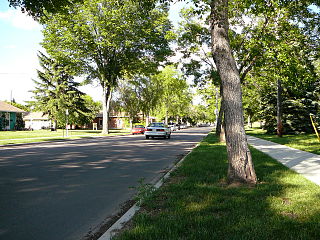Strathcona is a residential neighbourhood in south central Edmonton, Alberta, Canada. It is a part of, and should not be confused with, Old Strathcona, although much of the Strathcona neighbourhood is in Old Strathcona. The neighbourhood overlooks both the North Saskatchewan River and the Mill Creek Ravine.
Sherwood is a small neighbourhood in west Edmonton, Alberta, Canada. Originally part of the Town of Jasper Place, it became a part of Edmonton when Jasper Place amalgamated with Edmonton in 1964.

Grovenor is a residential neighbourhood in west Edmonton, Alberta, Canada. It was originally called Westgrove and a professional building on 142 Street still uses that name.

Holyrood is a residential neighbourhood in the Bonnie Doon area of south east Edmonton, Alberta, Canada. The name, Holyrood, is an anglicisation of the Scots haly ruid.

Idylwylde is a residential neighbourhood in south east Edmonton, Alberta, Canada.
Kenilworth is a residential neighbourhood in south east Edmonton, Alberta, Canada located just to the north of Whyte Avenue.
Prince Rupert is a triangle-shaped residential neighbourhood in north west Edmonton, Alberta, Canada. Prince Rupert is located within the old Hudson's Bay Reserve and was developed after the end of World War II. The neighbourhood is bounded on the south by 111 Avenue, on the west by 121 Street, and on the northeast by Kingsway Avenue.
Wellington is a residential neighbourhood located in north west Edmonton, Alberta, Canada.
Montrose is a residential neighbourhood in north east Edmonton, Alberta, Canada.
Balwin is a residential neighbourhood in north east Edmonton, Alberta, Canada. Originally part of North Edmonton, the area was annexed by the City of Edmonton in 1912.
Athlone is a residential neighbourhood in north west Edmonton, Alberta, Canada. The neighbourhood is named after the Earl of Athlone, Canada's governor-general from 1940 to 1946. The western portion of the neighbourhood is also called Dunvegan, after the Dunvegan Yards, a railway depot that existed on the site for some 70 years.
King Edward Park is a residential neighbourhood on south east Edmonton, Alberta, Canada. The neighbourhood was originally annexed by Edmonton in 1912.
Rosslyn is a residential neighbourhood in north west Edmonton, Alberta, Canada. The neighbourhood has good access to shopping services at Northgate Centre and North Town Mall.
Lauderdale is a residential neighbourhood in north west Edmonton, Alberta, Canada. It is named for "James Lauder who farmed and owned land near the neighbourhood before the turn of the 20th century".

Prince Charles is a residential neighbourhood in north west Edmonton, Alberta. The area was named in honour of Charles III, then known as Prince Charles.
Sherbrooke is a residential neighbourhood in north west Edmonton, Alberta, Canada.
Homesteader is a residential neighbourhood in the Hermitage area of north east Edmonton, Alberta, Canada.
Killarney is a residential neighbourhood located in north east Edmonton, Alberta, Canada. While the area became part of Edmonton in 1913, residential development did not occur until the 1950s and 1960s.
Kilkenny is a residential neighbourhood in north east Edmonton, Alberta, Canada. Most of the development in the neighbourhood occurred during the 1960s and 1970s. It was named after Kilkenny in Ireland.

Queen Alexandra is a mixed residential and commercial neighbourhood in south west Edmonton, Alberta, Canada. The neighbourhood, once part of the City of Strathcona, is named for Alexandra of Denmark. The north edge of the neighbourhood, along Whyte Avenue is part of Old Strathcona, a popular commercial and cultural area of Edmonton.





